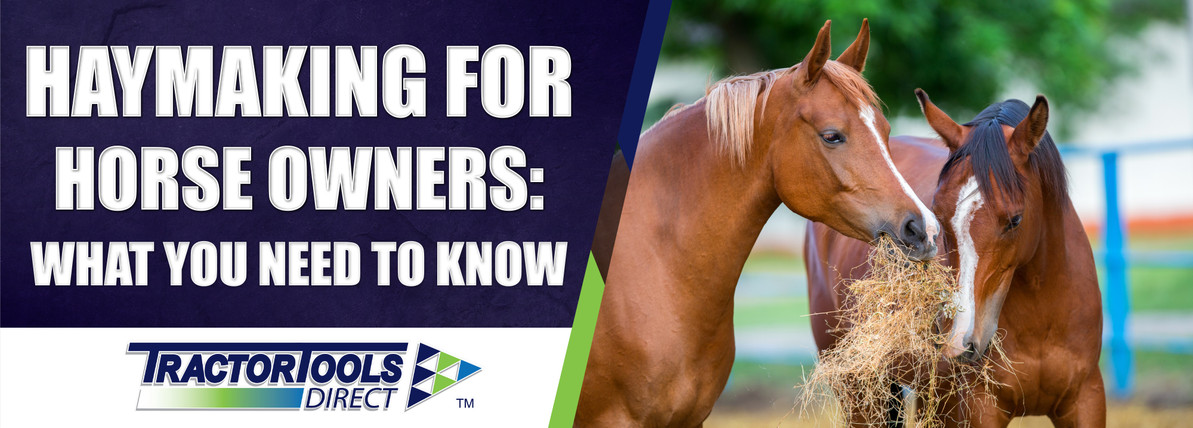Haymaking for Horse Owners: What You Need to Know
For horse owners, few things are more important than quality hay. Horses are picky eaters with sensitive digestive systems, and poor-quality forage can lead to health issues, wasted feed, and high replacement costs. If you have the land and equipment, making your own hay can be a smart and rewarding way to ensure consistent, high-quality nutrition for your animals. But it’s not just about cutting grass—it’s about knowing what horses need and using the appropriate tools to get it done right.
Horses require hay that is clean, mold-free, leafy, and soft, with low dust and no weeds or foreign matter. This means attention to every part of the haymaking process is essential—from cutting at the right time to curing and baling with care. You can learn more about cutting at the perfect time here: When to Cut: A Guide for Timing your Hay Harvest.
How to Get the Perfect Forage Cut for Horses
The process starts with cutting. Aim to harvest grass at early maturity, just before it heads out, to maintain protein levels and digestibility. Using a drum mower suited to your acreage will help ensure a clean, efficient cut that doesn’t shred leaves.
After cutting, the next step is curing—drying the hay to a moisture level safe for baling (around 15%). Horses are extremely sensitive to mold and dust, so complete, even drying is non-negotiable. A tedder helps fluff and spread the hay, speeding up the drying process and reducing the risk of spoilage. Once dry, a hay rake gathers the crop into windrows for baling.
Also important: storage. Keep bales dry and off the ground. Whether in a barn or under a tarp, airflow matters. Moldy hay not only gets wasted—it can make horses sick. Here are some more tips for storing hay: Tips for Storing Hay.
Compact Bales Work Best for Horses, Here's Why
When it’s time to bale, consider using a compact baler for easy handling and clean storage. Compact bales are ideal for horse owners because they’re easier to inspect for quality and handle. These bales also take up less space in the stable and in the horse trailer making them an ideal choice for equestrians on the show circuit – not to mention their lighter weight allows for easy tossing, transporting, and stacking!
The Benefits of Making Your Own Hay
Making your own hay gives you total control over your horse’s forage quality—and with the right weather, planning, and haymaking tools, you can ensure your horses get the clean, nutritious hay they need, straight from your own field.
FAQs – Haying for Horses
What type of hay is best for horses?
Horses do best with clean, soft, leafy hay that’s free from mold, weeds, and dust. Grasses like timothy, orchardgrass, and early-cut mixed grass/alfalfa blends are ideal.
When should I cut hay for horses?
Cut hay when grasses are in early bloom or just before heading out, which ensures a balance of digestibility and protein. This results in softer, more palatable forage for horses.
Why is moldy hay dangerous for horses?
Mold can cause respiratory problems, colic, and serious digestive upset in horses. That’s why even drying and proper storage are essential for horse hay.
What equipment is best for making hay for horses?
You’ll need a mower, tedder, rake, and a compact baler to ensure clean, dry, and manageable hay bales. Here at Tractor Tools Direct we also offer hay packages with incredible deals on all products combined.
Are small round bales better for horses than large round bales?
Absolutely! Small compact round bales are a great choice for horses. Their size makes them much easier to handle and transport compared to large bales, often without the need for special equipment. This also allows for better portion control, reducing waste and making individual feeding simpler. While still not as easy to inspect as square bales, their more manageable size allows for a better visual check for quality than enormous round bales.
How do I store hay safely for horses?
Keep bales of the ground, in a dry, well-ventilated area like a barn or under a tarp with airflow. Avoid stacking bales too tightly, which can trap moisture.
Need more information? Visit our website at www.tractortoolsdirect.com or give us a call at 260-BALE-HAY. We would be happy to help!
Recent Posts
-
Best Front Loader Attachments for Your Kubota BX Series Tractor
If you own a Kubota BX-series compact tractor, you already know it’s a versatile machine — but p …Dec 30th 2025 -
Boost Pine Straw Production Efficiency with Ibex Mini Round Balers
At Tractor Tools Direct, we're known for our high-quality hay equipment tailored for small farms …Dec 8th 2025 -
How to Winterize Your Tractor: Essential Maintenance Tips to Protect Your Investment
Farm equipment is one of the most valuable investments a farmer can make. At Tractor Tools Direc …Dec 1st 2025




